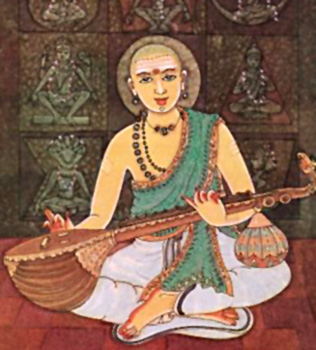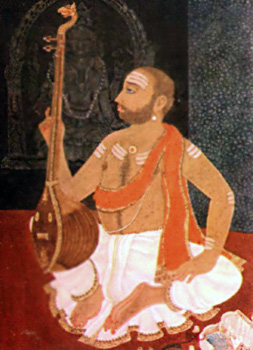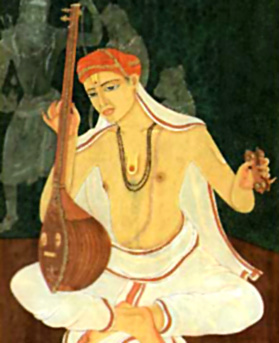 Kriti is one of the major genres of Carnatic Music occupying a large part of every South Indian Concert. Since the eighteenth century, kriti has been the most vital song-type of Carnatic music. The theme of a kriti text may be heroic, romantic, or narrative, but whether jocular or serious, most texts are devotional in nature. Kritis can be metered or prose. The majority of the texts are in Telugu language, Sanskrit language, and the Tamil language. Kritis can be performed in slow, medium, or fast speed, and in ghana raagas as well as in rakti raagas (those that express a particular sentiment). They are written in a variety of talas. Thousands of kritis have been composed by a number of composers.
Kriti is one of the major genres of Carnatic Music occupying a large part of every South Indian Concert. Since the eighteenth century, kriti has been the most vital song-type of Carnatic music. The theme of a kriti text may be heroic, romantic, or narrative, but whether jocular or serious, most texts are devotional in nature. Kritis can be metered or prose. The majority of the texts are in Telugu language, Sanskrit language, and the Tamil language. Kritis can be performed in slow, medium, or fast speed, and in ghana raagas as well as in rakti raagas (those that express a particular sentiment). They are written in a variety of talas. Thousands of kritis have been composed by a number of composers.
Origin of Kriti
The origins of kriti can be traced back to the kirtana, a genre of the fourteenth, fifteenth, and sixteenth centuries. During these times, many great musicians of South India were bhaktas, individuals who expressed their religious devotion through song. One of the greatest was Purandara Dasa, a sixteenth-century saint who composed many kirtanas in order to make his religious preaching more appealing to the masses. Purandara Dasa is often referred to as the "father of Carnatic music," both because he initiated the methodical study of music and because he established a precedent by composing songs in the vernacular rather than in Sanskrit. Kirtanas remain in currency today. In the eighteenth and nineteenth centuries, kriti attained prominence through the works of three of South India`s most famous composers, Tyagaraja, Syama Sastri, and Muttuswami Dikshitar, all of whom were born in the same village, Tiruvarur in Tanjore. Their works still dominate the Carnatic musical scene.
 Structure of Kriti
Structure of Kriti
Performers usually precede the singing or playing of a kriti with an alapana (comparable to the Hindustani alap). This helps the performer as well as the listener to prepare for the kriti and to establish the identity and mood of the raaga. The alapana should be no longer than the kriti. Most kriti have three sections: pallavi, anupallavi, and charanam. Many have multiple charana, which are set either to the same melody or to different melodies. All the charana should be of the same length so that the proportions are kept in balance. The pallavi returns after the anupallavi and also after the charanam. It must return at the same place in the tala cycle in which it originally appeared. The pallavi is thus a kind of cadence, just as the beginning phrases of the Hindustani dhrupad and khayal sthai were. In Carnatic music, the compositional structure does not necessarily aim toward count 1 (sama) as the demarcation point for phrases. Clearly, the sectional structure of kriti can vary from composition to composition. A kriti may even have only two sections- pallavi and a samashti charanam, which substitutes for the usual anupallavi and charanam.
Though the pallavi, anupallavi, and charanam are the basic elements of a kriti, this structure can be stretched to include several other elements: sangati, citta svara, svara sahitya, kalpana svara, and niraval. Sangati are composed variations developed on a musical theme. The greatest of all kriti composers, Tyagaraja, introduced these into the form. When present, they are integral to the composition and not an optional feature. The principle of variation is one of gradual change within the basic theme, to a point where the last sangati may be totally different from the original theme. Each new sangati is repeated. Frequently, the "pallavi repetition" is a repetition of the last pallavi sangati rather than of the "original" pallavi. The original placement of the text is retained throughout.
 Citta svara are composed passages sung to solfege syllables that may appear at the end of the anupallavi or at the end of the charanam. These passages are sometimes added to kritis by someone other than the original composer. They can be in the same speed as the kriti melody, or in a faster speed (double or quadruple the original speed). Theoretically, citta svara should present an aspect of the raga that is not covered by the kriti itself. Thus, a citta svara can be sung only with the one kriti for which it was composed. Unlike Hindustani dhrupad or khayal chiz, which theoretically encapsulate the entire essence of a raaga, a kriti may present only one aspect of the raaga. One would need to learn a number of compositions in the same raaga in order to obtain its gist.
Citta svara are composed passages sung to solfege syllables that may appear at the end of the anupallavi or at the end of the charanam. These passages are sometimes added to kritis by someone other than the original composer. They can be in the same speed as the kriti melody, or in a faster speed (double or quadruple the original speed). Theoretically, citta svara should present an aspect of the raga that is not covered by the kriti itself. Thus, a citta svara can be sung only with the one kriti for which it was composed. Unlike Hindustani dhrupad or khayal chiz, which theoretically encapsulate the entire essence of a raaga, a kriti may present only one aspect of the raaga. One would need to learn a number of compositions in the same raaga in order to obtain its gist.
Svara sahitya are citta svara passages for which a text has been composed. The text presumably continues the sense of the anupallavi and charanam texts. When a kriti includes svara sahitya, the solfege version (citta svara) is sung after the anupallavi and the text version (svara sahitya) is sung after the charanam. Another great kriti composer, Syama Sastri, introduced this element into kriti.
Kalpana svara passages are also sung to solfege, but they are improvised rather than composed. They can occur in pallavi, anupallavi, and charanam. Frequently less than one cycle long, they replace one or two words in a phrase of the original theme. The svara passage may then be expanded gradually in srotovaha fashion. Another possibility is to begin with a long kalpana svara, and then reduce it gradually in a shape called gopuccha yati (meaning like a cow`s tail). Whatever forms the artist improvises kalpana svara in, it must tie back into the composition smoothly.
 Niraval is the remaining type of improvisation that can appear in kriti. Here, the performer improvises melodic variations, keeping the text of the anupallavi or charanam, in basically the same relationship to the tala as it originally had been.
Niraval is the remaining type of improvisation that can appear in kriti. Here, the performer improvises melodic variations, keeping the text of the anupallavi or charanam, in basically the same relationship to the tala as it originally had been.
Composers of Kriti
Tyagaraja`s life (1759-1847) was devoted to the worship of God, particularly Lord Rama. He subsisted only by singing and begging. The famous musician became a saint and is remembered with reverence. His compositions predominate in the average South Indian recital. In Tyagaraja`s compositions, the kriti evolved from the kirtana to its present form. Placing emphasis more on the music than on the words, he kept text to a minimum. However, he followed the example of Purandara Dasa and wrote in a vernacular prose (Telugu) rather than in the more traditional Sanskrit poetry. Tyagaraja introduced sangati into the kriti form. About 700 of Tyagaraja`s texts remain, but it is impossible to know if all of their musical settings are his or if some were composed by his students. Syama Sastri (1762-1827) was a devout Brahmin. Like his contemporary, Tyagaraja, he was well educated, knew Sanskrit, and lived a life of devotion. He became famous both as a performing musician and as a composer of kritis. Although he composed about 300 pieces, only 30 of them have been popularized. Many were lost because he did not teach them to his disciples, just as Tyagaraja and Dikshitar did not. But whereas his two great contemporaries performed widely outside Tanjore, Sastri remained near home. He wrote in Sanskrit, Telugu, and occasionally Tamil, and composed intricate passages of solfege syllables. His kritis are of a very scholarly nature and are very demanding in their use of tala. For these reasons, they cannot be learned as easily as Tyagaraja`s kritis.
Muttuswami Dikshitar (1776-1835) was a scion of a distinguished musical family. He was greatly influenced by Hindustani Classical music and this effect is even seen in his compositions. Though Tamil was his native tongue, Dikshitar wrote texts only in Sanskrit. His verse is technically complex and contains many references to ancient mythology in a context of praise of God. His musical style is dignified, his form through-composed without sectional repetition, and his purpose to explore the raaga thoroughly. His songs move at a slow tempo and are heavily ornamented. Dikshitar was also skilled at tala, and at the end of one or more sections of his compositions there is often a passage in dvikala or catuskala for rhythmic contrast. Like Sastri`s kritis and unlike Tyagaraja`s, the kritis of Dikshitar require repeated hearing to be understood.
The flexibility inherent in the basic kriti form has attracted many composers. Moreover, kriti has been incorporated intact into solo instrumental performances. Since kriti is a musical composition rather than a textual composition, its performance on instruments is seen as posing no difficulty.




















